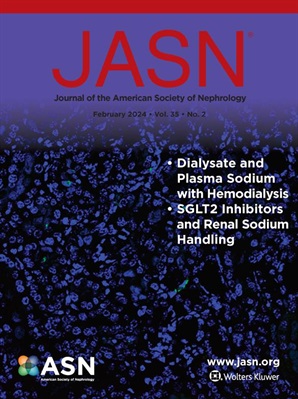Hmx2和Dmrt2协调肾脏插层细胞亚型的分化。
IF 9.4
1区 医学
Q1 UROLOGY & NEPHROLOGY
引用次数: 0
摘要
背景:肾收集管中的插层细胞对维持全身酸碱平衡至关重要。根据基因表达谱和功能特征,将插入细胞分为A型、B型和非A/非B型。虽然有几种转录因子被报道调节插层细胞的分化,但插层细胞亚型的命运是如何建立的仍不清楚。方法为了研究Dmrt2和Hmx2在插入细胞亚型分化中的作用,我们在小鼠肾远端细胞段特异性地进行了单次或双次条件缺失和敲入,并分析了它们对尿液酸化的影响。我们还对小鼠和人类肾脏数据集进行了单细胞RNA测序分析,以追踪嵌入细胞祖细胞的命运轨迹。结果Hmx2在远端肾元中的缺失阻止了b型插层细胞的分化,而Hmx2和Dmrt2的同时缺失会损害a型插层细胞的分化,同时Hmx3的表达和b型插层细胞的分化增加。Dmrt2敲入小鼠显示a型插入细胞分化适度增加,b型插入细胞分化明显减少。值得注意的是,Dmrt2敲入蛋白并不能挽救在Foxp1缺陷小鼠中观察到的嵌入细胞分化缺陷。对小鼠和人单细胞RNA测序数据的分析进一步证实了Hmx2和Dmrt2在肾脏中的互斥表达模式。结论shmx2和Dmrt2是调控肾插层细胞亚型分化的重要且互斥的转录因子,其中Hmx2决定b型插层细胞的命运,Dmrt2促进a型插层细胞的分化。Dmrt2抑制Hmx2和Hmx3的表达。在缺乏Dmrt2和Hmx2的情况下,Hmx3的表达被激活,促进b型插层细胞分化。本文章由计算机程序翻译,如有差异,请以英文原文为准。
Hmx2 and Dmrt2 Coordinate the Differentiation of Intercalated Cell Subtypes in Kidney.
BACKGROUND
Intercalated cells in the kidney collecting ducts are essential for maintaining systemic acid-base homeostasis. Based on gene expression profiles and functional characteristics, intercalated cells are classified into type A, type B, non-A/non-B. While several transcription factors have been reported to regulate intercalated cells differentiation, how the fates of intercalated cell subtypes are established remains unclear.
METHODS
To investigate the roles of Dmrt2 and Hmx2 in intercalated cell subtype differentiation, we generated mice with single or double conditional deletion and knock-in of these transcription factors specifically in distal nephron segments and analyzed their effects on urine acidification. We also performed single-cell RNA sequencing analysis on mouse and human kidney datasets to trace intercalated cell progenitor fate trajectories.
RESULTS
Loss of Hmx2 in the distal nephron prevented type-B intercalated cell differentiation, whereas simultaneous deletion of Hmx2 and Dmrt2 compromised type-A intercalated cell differentiation, with a concomitant increase in Hmx3 expression and type-B intercalated cell differentiation. Dmrt2 knock-in mice exhibited a modest increase in type-A intercalated cell differentiation and a marked reduction in type-B intercalated cells. Notably, Dmrt2 knockin did not rescue the intercalated cell differentiation defects observed in Foxp1 deficient mice. Analysis of mouse and human single cell RNA sequencing data further confirmed the mutually exclusive expression patterns of Hmx2 and Dmrt2 in the kidney.
CONCLUSIONS
Hmx2 and Dmrt2 were essential, mutually exclusive transcription factors that govern intercalated cell subtype differentiation in the kidney, with Hmx2 specifying type-B intercalated cell fate and Dmrt2 promoting type-A intercalated cell differentiation. Dmrt2 supressed the expression of Hmx2 and Hmx3. In the absence of Dmrt2 and Hmx2, Hmx3 expression was activated to promote type-B intercalated cell differentiation.
求助全文
通过发布文献求助,成功后即可免费获取论文全文。
去求助
来源期刊
CiteScore
22.40
自引率
2.90%
发文量
492
审稿时长
3-8 weeks
期刊介绍:
The Journal of the American Society of Nephrology (JASN) stands as the preeminent kidney journal globally, offering an exceptional synthesis of cutting-edge basic research, clinical epidemiology, meta-analysis, and relevant editorial content. Representing a comprehensive resource, JASN encompasses clinical research, editorials distilling key findings, perspectives, and timely reviews.
Editorials are skillfully crafted to elucidate the essential insights of the parent article, while JASN actively encourages the submission of Letters to the Editor discussing recently published articles. The reviews featured in JASN are consistently erudite and comprehensive, providing thorough coverage of respective fields. Since its inception in July 1990, JASN has been a monthly publication.
JASN publishes original research reports and editorial content across a spectrum of basic and clinical science relevant to the broad discipline of nephrology. Topics covered include renal cell biology, developmental biology of the kidney, genetics of kidney disease, cell and transport physiology, hemodynamics and vascular regulation, mechanisms of blood pressure regulation, renal immunology, kidney pathology, pathophysiology of kidney diseases, nephrolithiasis, clinical nephrology (including dialysis and transplantation), and hypertension. Furthermore, articles addressing healthcare policy and care delivery issues relevant to nephrology are warmly welcomed.

 求助内容:
求助内容: 应助结果提醒方式:
应助结果提醒方式:


